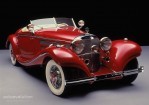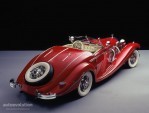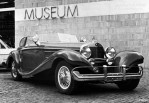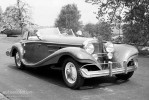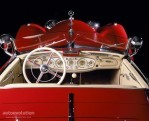Body style: Convertible (spider/spyder, cabrio/cabriolet, drop/open/soft top)
Segment: Roadster & Convertible
Production years: 1936
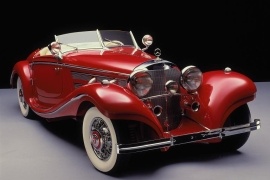 10 Photos
10 PhotosThe 500 K Special Roadster was one of the fastest cars from its times a customer could buy from Mercedes-Benz, and it became a cult car over the years.
In 1934, Mercedes-Benz started to replace the previous 380 model with a new generation and unveiled the 500, W29 range. By enlarging the bore and lengthening the engine's stroke, the 3.8-liter inline-eight engine grew to five liters. To further increase the power, Mercedes added a Roots supercharger with a switch on the dashboard.
The new chassis allowed the carmaker to create a long bodywork with only two seats in the cabin and two rumble seats in the back, the so-called "mother-in-law" seats by the Germans. The front of the car showed the rear-set engine position, meaning that the powerplant was installed behind the front axle. Even the pinned-out radiator sat behind the wheels hubs. The carmaker added a thick, rigid front bumper extended in front of the wheel fenders. It was a so-called "Autobahn-Kurierwagen" that described the cars built for sustained high-speed travels. A two-part, raked windshield protected the occupants from the wind. Behind the cabin, on the sloped rear end, the carmaker installed two spare wheels. One was in a special compartment covered by a lid. When both wheels were installed, that lid was removed, and the second spare came on top.
Mercedes-Benz installed rear-hinged doors to access the luxurious cabin. The leather upholstery and the wood panels were finished to perfection. A big, four-spoke steering wheel ensured the driver that it had the best possible control over the car.
Under the long hood, Mercedes-Benz installed a long engine and two additional horns. The supercharger increased the power from 100 hp to 160 hp at a touch of a button. The carmaker paired the inline-eight unit with a semi-automatic four-speed gearbox. Shifting from third to fourth didn't require the use of the clutch.
MERCEDES BENZ Typ 500 K Spezial-Roadster (W29) 1936
- 500 Kompressor
MERCEDES BENZ Typ 500 K Spezial-Roadster (W29)
500 Kompressor
ENGINE SPECS - 500 Kompressor | |
|---|---|
| Cylinders: | L8 |
| Displacement: | 5018 cm3 |
| Power: | 118 KW @ 3400 RPM 160 HP @ 3400 RPM 158 BHP @ 3400 RPM |
| Fuel System: | Carburetor |
| Fuel: | Gasoline |
PERFORMANCE SPECS | |
|---|---|
| Top Speed: | 100 mph (161 km/h) |
TRANSMISSION SPECS | |
|---|---|
| Drive Type: | Rear Wheel Drive |
| Gearbox: | Manual, 5 Speed |
BRAKES SPECS | |
|---|---|
| Front: | Drums |
| Rear: | Drums |
TIRES SPECS | |
|---|---|
| Tire Size: | 7.00-17 |
DIMENSIONS | |
|---|---|
| Length: | 196.9 in (5001 mm) |
| Width: | 74 in (1880 mm) |
| Height: | 59.8 in (1519 mm) |
| Front/rear Track: | 60.4/60.9 in (1,534/1,547 mm) |
| Wheelbase: | 129.5 in (3289 mm) |
WEIGHT SPECS | |
|---|---|
| Gross Weight Limit: | 5952 lbs (2700 kg) |
FUEL ECONOMY (NEDC) | |
|---|---|
| Combined: | 8.7 mpg US (27 L/100Km) |
| CO2 Emissions: | 643 g/km |
